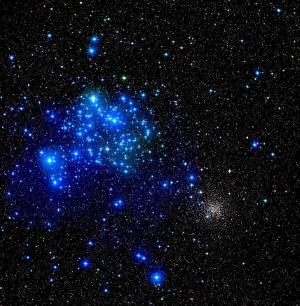Dust glows blue in this image of Messier 35, a young star cluster in Gemini. Some of the dust, which reflects starlight, is left over from the cluster's birth. The cluster is about 175 million years old and about 3,000 light-years away. A second cluster, NGC 2158, forms a tight white group to the lower right of center. [Canada-France-Hawaii Telescope/2003]
You are here
Messier 35
Many bright, beautiful stars highlight winter nights. The bounty includes Castor and Pollux, the twins of Gemini. But a family of stars at the feet of the twins would put our night sky to shame. It’s a cluster that may contain several thousand stars packed into a fairly small volume of space. And quite a few of those stars are bright. So from a planet inside the cluster, the night sky would sparkle with many stars that are brighter than any in the skies of Earth.
Messier 35 is almost 3,000 light-years away, and it spans a couple of dozen light-years. So as seen from Earth, it covers an area as big as the Moon.
The cluster is about 175 million years old — only a tiny fraction of the age of the Sun. One way astronomers determine that age is by measuring the “weight” of the stars that are still in the prime of life. The lifespan of a star depends on its mass, with the most-massive stars burning out first. Astronomers know how long it takes stars of different masses to expire. So finding the heaviest stars that are still in the prime of life provides a good indication of the cluster’s age — in this case, about 175 million years.
Gemini is in the eastern sky at nightfall. Castor and Pollux are at the left of the constellation, with slightly fainter Castor above its “twin.” The bodies of the twins stretch to the right. M35 is at the feet of the twins, far to the upper right of Castor and Pollux.
Script by Damond Benningfield
Get Premium Audio
Listen to today's episode of StarDate on the web the same day it airs in high-quality streaming audio without any extra ads or announcements. Choose a $8 one-month pass, or listen every day for a year for just $30.



